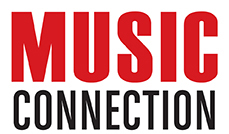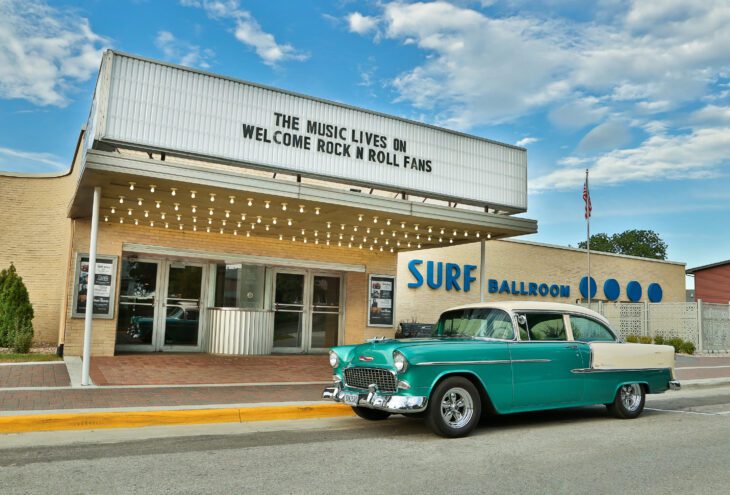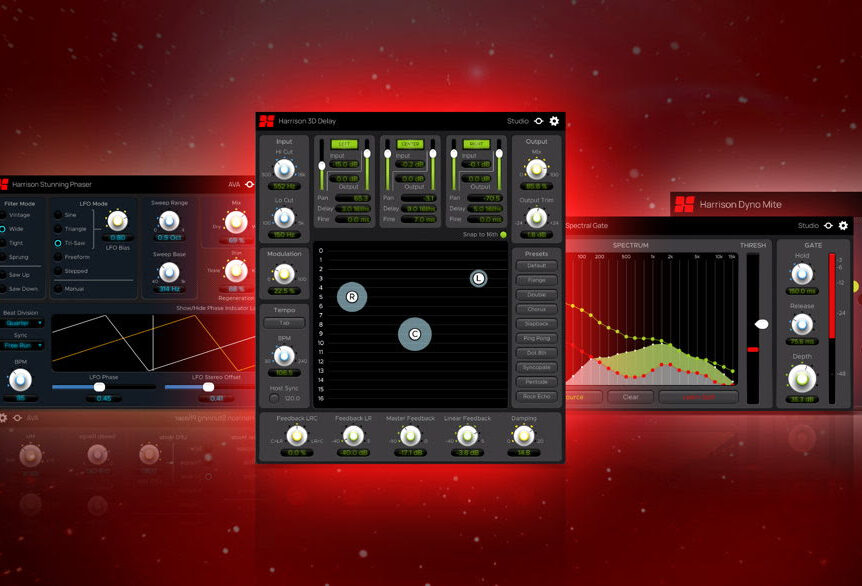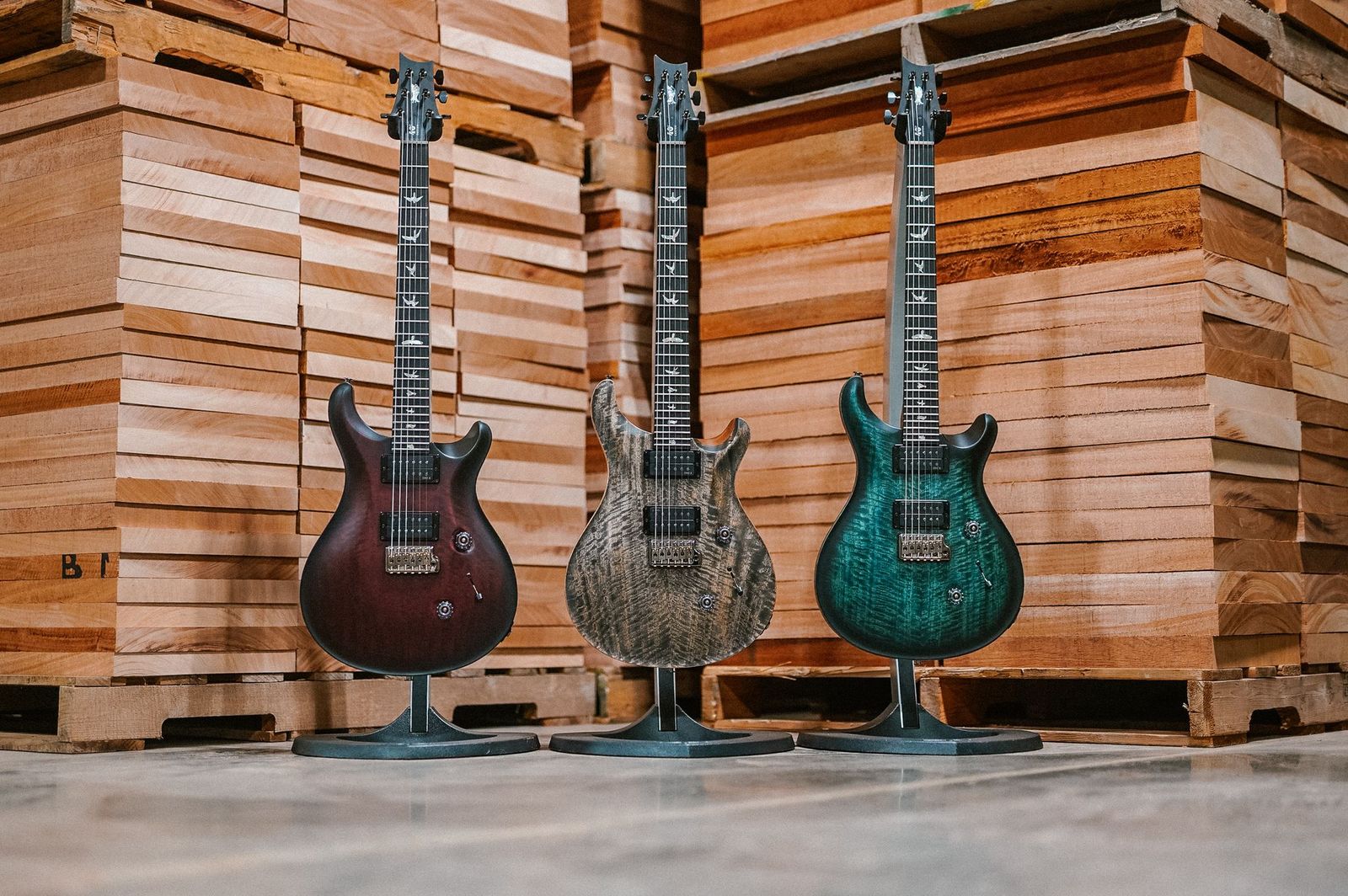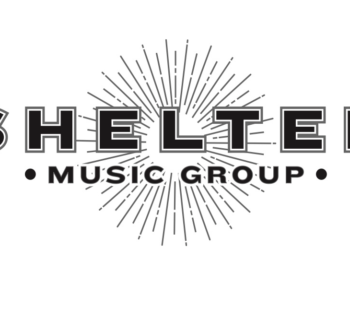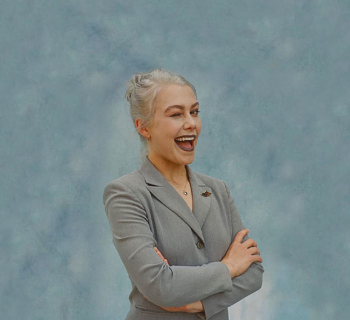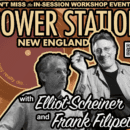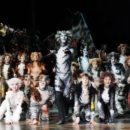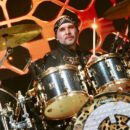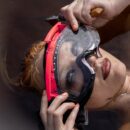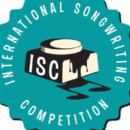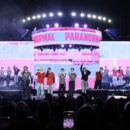This September, the Surf Ballroom & Museum will unveil ‘Not Fade Away: The Immersive Surf Ballroom Experience’ – a permanent first-of-its-kind experience honoring the legacy of Buddy Holly, Ritchie Valens, and J.P. “The Big Bopper” Richardson in Clear Lake, Iowa. Opening festivities kick off on Thursday, September 4, with a book signing and special preview, leading up to the full exhibit debut and ribbon cutting on Sunday, September 7 – what would have been Buddy Holly’s 88th birthday. Housed in the newly-completed Music Enrichment Center (MEC) adjacent to the historic Surf Ballroom, ‘Not Fade Away’ is more than an exhibit — it’s a transformative, multi-sensory journey through the birth of rock 'n' roll and the timeless sound that changed American music forever. Through immersive digital storytelling, historic artifacts, restored audio, and original archival materials, guests will walk in the footsteps of legends.
A press release from 2911 Media further describes the endeavor:
“Not Fade Away reflects the power of public-private partnership and our shared commitment to preserving and promoting Clear Lake’s unique place in American music history,” said Clear Lake Mayor Nelson Crabb. “This project brings national attention, educational opportunity, and cultural significance to our community. It’s an investment not only in heritage, but in our future.”
“This is a moment years in the making,” said Brian Luallen, CEO of the Surf Ballroom & Museum. “We’ve combined cutting-edge technology with the soul of rock ‘n’ roll to tell a story that is as moving as it is unforgettable. ‘Not Fade Away’ honors the legacy of the artists who helped define a generation—and reminds us why their music still matters today.”
Never-before-seen artifacts on display at the Surf Music Experience Center include:
Les Paul innovations:
- One of only two existing prototypes for the solid body electric guitar called “The Log,” hand built by Les Paul in approximately 1937
- Les Paul's original handwritten plans for the very first 8-track tape recording device
- Les Paul's original 8-track console, which revolutionized modern recording
- 1970 custom Gibson guitar owned and played by Les Paul
- Les Paul's signature groundbreaking “Paulverizer,” one of only three in existence
Celebrity musician artifacts:
- Guitar signed by Buddy Holly while on the 1959 Winter Dance Party Tour
- Les Paul guitar owned and played by Slash, former lead guitarist of Guns ‘n’ Roses
- Les Paul guitar owned and played by Warren Haynes, formerly of the Allman Brothers
- Stratocaster signed by legendary blues guitarist Buddy Guy
- BB King signed "Lucille" guitar
- Willie Nelson signed guitar
- Don McLean signed American Pie LP and guitar
- Accordion owned and played by Lawrence Welk
- Leather top hat worn by Slash
Personal effects of Holly, Valens, and Richardson:
- Microphone used by Buddy Holly at his last performance at The Surf Ballroom in 1959
- Red corduroy jacket Buddy Holly wore during his last performance in San Antonio, TX
- Original camera that was used to take the Pulitzer-nominated photos of the fatal plane crash on Feb 3, 1959, that killed Buddy Holly, Ritchie Valens, and J.P. “The Big Bopper” Richardson
- Hand-tooled leather wallet owned by Ritchie Valens and recovered from the crash
- Briefcase owned by J.P. "The Big Bopper" Richardson and recovered from the crash
- A pair of cufflinks owned by Buddy Holly and recovered from the crash
- Ritchie Valens original Del-Fi Gold Record for "La Bamba" and "Donna"
- Upright bass from the final performance of Buddy Holly’s band, The Crickets
For the board of the North Iowa Cultural Center & Museum (NICCM), the nonprofit that owns and operates the Surf Ballroom, the launch is deeply personal.
“This isn’t just about music,” said Jeff Nicholas, President of NICCM’s Board of Directors. “It’s about memory, emotion, and the voices that continue to echo across generations. With ‘Not Fade Away,’ we’re creating a space where history comes alive—and where our children and grandchildren can understand just how powerful one song, one show, or one moment can be.”
The experience is offered in multiple ticket tiers, including exclusive VIP packages that provide access to the Surf Ballroom, immersive gallery, and the historic Carl Fox House, once home to the Surf’s founder. Ticket prices start at $19 and group rates are available. Admission is discounted for city and Cerro Gordo county residents, as well as military veterans, seniors and kids. A full schedule of opening events will be released in the coming weeks.
This September, the Surf Ballroom & Museum will unveil ‘Not Fade Away: The Immersive Surf Ballroom Experience’ – a permanent first-of-its-kind experience honoring the legacy of Buddy Holly, Ritchie Valens, and J.P. “The Big Bopper” Richardson in Clear Lake, Iowa. Opening festivities kick off on Thursday, September 4, with a book signing and special preview, leading up to the full exhibit debut and ribbon cutting on Sunday, September 7 – what would have been Buddy Holly’s 88th birthday. Housed in the newly-completed Music Enrichment Center (MEC) adjacent to the historic Surf Ballroom, ‘Not Fade Away’ is more than an exhibit — it’s a transformative, multi-sensory journey through the birth of rock 'n' roll and the timeless sound that changed American music forever. Through immersive digital storytelling, historic artifacts, restored audio, and original archival materials, guests will walk in the footsteps of legends.
A press release from 2911 Media further describes the endeavor:
“Not Fade Away reflects the power of public-private partnership and our shared commitment to preserving and promoting Clear Lake’s unique place in American music history,” said Clear Lake Mayor Nelson Crabb. “This project brings national attention, educational opportunity, and cultural significance to our community. It’s an investment not only in heritage, but in our future.”
“This is a moment years in the making,” said Brian Luallen, CEO of the Surf Ballroom & Museum. “We’ve combined cutting-edge technology with the soul of rock ‘n’ roll to tell a story that is as moving as it is unforgettable. ‘Not Fade Away’ honors the legacy of the artists who helped define a generation—and reminds us why their music still matters today.”
Never-before-seen artifacts on display at the Surf Music Experience Center include:
Les Paul innovations:
- One of only two existing prototypes for the solid body electric guitar called “The Log,” hand built by Les Paul in approximately 1937
- Les Paul's original handwritten plans for the very first 8-track tape recording device
- Les Paul's original 8-track console, which revolutionized modern recording
- 1970 custom Gibson guitar owned and played by Les Paul
- Les Paul's signature groundbreaking “Paulverizer,” one of only three in existence
Celebrity musician artifacts:
- Guitar signed by Buddy Holly while on the 1959 Winter Dance Party Tour
- Les Paul guitar owned and played by Slash, former lead guitarist of Guns ‘n’ Roses
- Les Paul guitar owned and played by Warren Haynes, formerly of the Allman Brothers
- Stratocaster signed by legendary blues guitarist Buddy Guy
- BB King signed "Lucille" guitar
- Willie Nelson signed guitar
- Don McLean signed American Pie LP and guitar
- Accordion owned and played by Lawrence Welk
- Leather top hat worn by Slash
Personal effects of Holly, Valens, and Richardson:
- Microphone used by Buddy Holly at his last performance at The Surf Ballroom in 1959
- Red corduroy jacket Buddy Holly wore during his last performance in San Antonio, TX
- Original camera that was used to take the Pulitzer-nominated photos of the fatal plane crash on Feb 3, 1959, that killed Buddy Holly, Ritchie Valens, and J.P. “The Big Bopper” Richardson
- Hand-tooled leather wallet owned by Ritchie Valens and recovered from the crash
- Briefcase owned by J.P. "The Big Bopper" Richardson and recovered from the crash
- A pair of cufflinks owned by Buddy Holly and recovered from the crash
- Ritchie Valens original Del-Fi Gold Record for "La Bamba" and "Donna"
- Upright bass from the final performance of Buddy Holly’s band, The Crickets
For the board of the North Iowa Cultural Center & Museum (NICCM), the nonprofit that owns and operates the Surf Ballroom, the launch is deeply personal.
“This isn’t just about music,” said Jeff Nicholas, President of NICCM’s Board of Directors. “It’s about memory, emotion, and the voices that continue to echo across generations. With ‘Not Fade Away,’ we’re creating a space where history comes alive—and where our children and grandchildren can understand just how powerful one song, one show, or one moment can be.”
The experience is offered in multiple ticket tiers, including exclusive VIP packages that provide access to the Surf Ballroom, immersive gallery, and the historic Carl Fox House, once home to the Surf’s founder. Ticket prices start at $19 and group rates are available. Admission is discounted for city and Cerro Gordo county residents, as well as military veterans, seniors and kids. A full schedule of opening events will be released in the coming weeks.
The legendary Surf Ballroom & Museum is one of only four music venues in the United States designated as a National Historic Landmark. Best known as the final performance site of Buddy Holly, Ritchie Valens, and the Big Bopper, the Surf has welcomed generations of musical artists and fans since 1933. Today, it is a vibrant year-round venue that amplifies the legacy of music culture, education and performance – it’s where the music lives. The Surf is operated by the North Iowa Cultural Center & Museum, a 501(c)(3) nonprofit organization, and will expand its offerings with the new Music Experience Center (MEC), an immersive attraction, artifact exhibit and event space, opening September 2025. For tickets, event details and more information, visit https://surfballroom.com/mec-immersive-experience-tour/. ‘Not Fade Away’ will operate year-round and includes educational and group tour components. Surf Ballroom & Museum: 460 North Shore Drive Clear Lake, Iowa 50428 (641) 357-6151 surfballroom.com.”
February 3, 2025 was the 66th anniversary of tragic airplane crash that subsequently became known as “The Day the Music Died,” sadly referenced in Don McLean’s song, “American Pie.” Buddy Holly, Ritchie Valens and J.P. Richardson aka The Big Bopper died along with pilot Roger Peterson.
After a February 2, 1959 “Winter Dance Party” show in Clear Lake, Iowa, Buddy Holly, Ritchie Valens and J.P. Richardson took off from the Mason City airport, in a three-passenger airplane that Holly chartered piloted by Roger Peterson during inclement weather. It crashed into a cornfield in nearby Macon City, Iowa, just minutes after take-off.
I will always remember the February 3, 1959 front page headline in The Los Angeles Times-Mirror, a daily newspaper who reported this accident.
Ritchie Valens’ death was a very big regional loss. He was from Pacoima, a suburb in Southern California. Ritchie’s records were very popular in Los Angeles and the surrounding communities. It was KFWB-AM deejay Gene Weed who first spun his music and the radio station held what seemed like an all-day shiva celebrating the life of Valens, whose record label, Del-Fi, was based in Hollywood.
I saw footage of Buddy Holly once on Dick Clark’s American Bandstand, and earlier, when Holly was on The Ed Sullivan Show in 1958. Holly’s records were also spun on Southern California AM radio station KFWB. “Chantilly Lace” by The Big Bopper was a national hit.
In my 1998 interview with Dick Clark, I asked who was the most requested recording artist for licensing?
“Buddy Holly. The irony there was that we once did a retrospective show for ABC, and I had an editor in from San Francisco who lost the Buddy Holly footage.Never found it. The only Buddy Holly footage we have of him doing ‘Peggy Sue’ is from The Arthur Murray Dance Party. I’m still a friend of Mrs. Murray and her former husband who passed on.I told her, ‘Let me have your tapes.You’ll own them always. We’ll just administrate them and we’ll take good care of them and store them in various formats so they won’t get lost.”
On February 3, 1999 I interviewed Keith Richards around a Rolling Stones concert in San Diego. We talked primarily about his just released Wingless Angels album.
However, it wasn’t lost on each of us that 42 years earlier, Buddy Holly, one of his musical heroes, passed. An early hit record of the Rolling Stones was “Not Fade Away,” produced by Andrew Loog Oldham, was the B-side to Buddy Holly’s 1957 chart hit “Oh Boy!”
In March 1958, 14-year old Mick Jagger saw his first rock concert in London at the Woolwich, Granada. “Not Fade Away” made a big impression.
Keith and I had a brief discussion how some music, like his Wingless Angeles endeavour or the sounds of the legendary Sun Records label, or anything by Holly and Eddie Cochran makes immediate impact and a connection on your soul, even decades after initial airplay or retail discovery.
“It sticks. I think because it’s timeless music I call it ‘marrow music.’ Not even bone music. It strikes to the marrow. It’s like a faint echo . . . The body responds to it and I don’t know why…”
“La Sangre Llama” (The Blood Calls).
The music and recorded catalogue of Buddy Holly never died, and the sonic legacy of Ritchie Valens has continued. “Chantilly Lace” is constantly heard daily on oldies and classic rock radio stations. Humourist and songwriter J.P. Richardson, pka The Big Bopper, wrote “White Lighting” that George Jones recorded, and penned “Running Bear” for Johnny Horton. J.P. Richardson is in the Rockabilly Hall of Fame.
Singer/songwriter McLean acknowledged the event in his 1971 hit tune “American Pie.”
Now, almost 40 years after its 1987 theatrical release, La Bamba, the biopic of Ritchie Valens, is getting a remake of the Luis Valdez written and directed film. In 2023, Variety reported that Sony Pictures and Mucho Mas Media are in development of a new version. Oscar-nominated writer José Rivera, known for The Motorcycle Diaries and On the Road, will pen the script, and Valdez will serve as an executive producer.
In January 2025, as ongoing fires engulf and devastate the entire region of Southern California, the Ritchie Valens Recreation Center at the Ritchie Valens Park in Pacoima on 10736 Laurel Canyon Blvd. is serving as shelter and evacuation center for the now homeless victims that are affected by the wildfires.
In Southern California during 2017, a stretch of the Golden State (5) Freeway, is called The Ritchie Valens Memorial Highway, located between the 170 and 118 freeways was named for the Rock and Roll Hall of Fame inductee.
Last decade I asked two friends of mine, author/music historian, Roger Steffens, and the late multi-instrumentalist and songwriter Chris Darrow, to share their concert memories of witnessing Buddy Holly and Ritchie Valens perform.
Roger Steffens: At Christmas 1957 I went to my first rock and roll show, Alan Freed's giant Christmas Jubilee of Stars at the Paramount Theater on Times Square. The run broke all attendance records, including the previous best, a Frank Sinatra tour in 1944.My friends and I had to lie to our parents, because they were sure we would be mugged if we went to a show where a lot of black kids were going to be.
“So, we told them we were going to Hackensack to see a movie, but got on the bus to the Port Authority instead and walked the few blocks to the Paramount, which had a line stretching three times around the block.
“The show included Fats Domino, Jerry Lee Lewis (back to back), the teenage Everly Brothers, the Teenagers, Lee Andrews and the Hearts (with Questlove's father), Danny and the Juniors, The Dubs (dear to my reggae soul) and eight others. Most of the second line performers got only one or two songs each, but Buddy Holly and the Crickets got five, because they were on the charts under both names at the time. They were all dressed in tuxedos, and played with a stand-up bass.
“The audience went wild for Buddy, clapping along with his rhythms, and singing along with his parade of hits. I remember watching Alan Freed's 5-6 pm Rock and Roll Party TV show on WABD, Channel 5, in New York City.
“He interviewed Buddy about the national tour they had done together in 1956, during which they flew in a small plane to get to a gig, and encountered severe turbulence. Buddy recalled the ‘woop-woop’ as the plane fell and climbed and fell again. What a premonition!
“It was one of the saddest days of my youth when we learned of that terrible crash that took his life, and the first time I cried over the loss of a performer. Odd that one of the final releases during his short lifetime was ‘It Doesn't Matter Anymore.’”
Chris Darrow: I saw Ritchie Valens a month before his death in Pomona at the Rainbow Gardens, an all-wooden building, with a low ceiling that was just south of the YMCA in Pomona, California. It later was to burn to the ground.
“I was from a mixed race white and Hispanic neighborhood in Claremont, called Arbol Verde. My best friend Roger Palos was Mexican, and he and I were both learning to play guitar and we would sing together a lot.The songs that we learned that were not from the folk music genre, were popular songs mainly by Elvis Presley, the Everly Brothers, Buddy Holly, and Ritchie Valens.For some reason our favorite song of Ritchie’s was not ‘La Bamba’ or ‘Oh, Donna’ but ‘Hi – Tone.’We just loved that song.
“I was 15 and in the ninth grade and was not allowed to go out many places by myself at night. I was attending a private school in Claremont, called Webb, which had sons of famous people in my class. Chris Mitchum, son of Robert, Chris Reynolds, his father owned the L.A. Angels professional baseball team, Tom Mitchell, whose father invented the Mitchell 35mm movie camera and Bob Washburn, whose dad was the head of 7UP.
“Since I wasn’t driving yet, it took a lot for my folks to let me go into the dark part of Pomona to see a rock ‘n’ roll show in 1959. My parents weren’t square but my mom always worried about me.
‘“I went with Roger Palos and Jon Dearborn to the concert, and it was kind of a pilgrimage for us. Since I really identified with the Mexican culture and wasn’t afraid, I couldn’t wait to see one of my main men, Ritchie Valens. After all he was only 17 and not much older than Roger and me. I wore my bright, red corduroy coat with silver buttons that my Grandma Darrow had made for me that Christmas. I also wore white bucks, white pants and red argyle socks. I looked sharp!
“I’m not sure who the house band was, but it could have been Manual and the Renegades, or the Mixtures, for they both used to be regulars at the Rainbow Gardens. I was very excited and hadn’t been to too many concerts before this.
“I listened to a lot of radio at the time and because of the heavy Mexican influence in my life, I got turned on to KDAY with Art Laboe, who would broadcast live from Scribner’s Drive-In, and Ol’ HH -Hunter Hancock- who had a great show called Harlem Matinee. These were the guys that the Mexicans listened to on the radio. I was also into KFWB, with Al Jarvis, Bill Balance and Ted Quillan, and Dick Hugg ‘Huggy Boy’ on KGFJ. He was on so late at night that I would have to listen to him under the covers of my bed in my room. So what is now called Doo-Wop was big with me, as well as the white dominated music so prevalent on major radio stations of the time. The Oldies but Goodies albums by Laboe on Original Sound were right up my alley.
“I was really into dancing at the time and had a chance to dance a few numbers with some strangers at the show. The opening act for Ritchie was Jan & Dean; possibly really Jan & Arnie. In those days no one had their own bands and acts would use house bands as their own. Either the band didn’t like Jan & Dean or they just didn’t care. Before they could get through the first song, which sounded awful, Jan stopped, ran off the stage followed by Dean, and plowed through the locked stage door and out into the night. Jan just kicked it open like some thug in a movie. I was so shocked and dumbstruck by this. They never came back.
“After the commotion died down and it was time for Ritchie to come on. He whirled in, probably from some other gig earlier that night, and I went right up next to the edge of the stage. He was a pretty big guy and loomed on-stage with a graceful power. He was not overtly hard core in his presentation but was very soulful and I ate it up. There was a tenderness and sweetness about him, even as he rocked. The house band knew his stuff and did a great job on the songs. He did ‘La Bamba’ and ‘Oh, Donna’ and even played my favorite song, ‘Hi-Tone.’
“I liken Ritchie to another L.A. guy, Eddie Cochran. Both had the soul and drive of the Sun /Clovis, New Mexico records, but they were from our own backyard. As soon as Ritchie finished, he was whisked off in a flash. There was no chance to say ‘hello’ or offer a handshake, but I was ecstatic over the event.
“The house band played on to people doing The Stomp and I was awarded a prize for being one of the five best- dressed guys of the night. A perfect end to a perfect evening.
“I read somewhere that Frank Zappa saw Ritchie in Pomona, so he was probably there, too. A month after the gig I was at school and heard about the deaths of Ritchie, Buddy and The Big Bopper. I was crushed and went off by myself and cried like a baby. It was the first time I remember crying for someone who had died. Ritchie Valens and Buddy Holly were like gods to me at the time and could do no wrong. It was one of the great losses in rock and roll history.”
